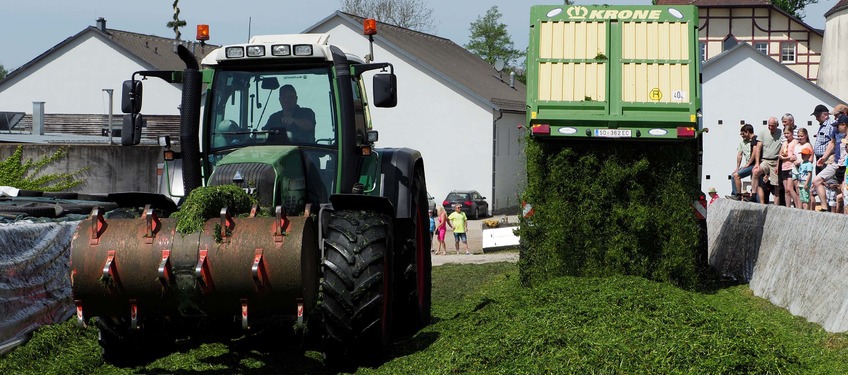Nevertheless, silo professionals from Austria showed that the production of excellent fermented feed is possible. The top silage qualities were selected by a jury of experts and awarded in six categories at the first online silage day on March 6, 2021.
| category | Place | Operation | Location | country | TM | Crude protein | NEL |
| g/kg FM | g/kg DM | MJ/kg DM | |||||
| Grass silage 1 | 1 | Schober Gerhard | St. Lawrence | STYRIA | 418 | 181 | 6,78 |
| 2 | Neumüller Wolfgang | Niederwaldkirchen | UPPER AUSTRIA | 280 | 185 | 6,56 | |
| 3 | Braumann Josef | Seekirchen | SALZBURG | 416 | 155 | 6,53 | |
| Grass silage 2 | 1 | Mushroom Stefan | Neuhofen/Ybbs | LOWER AUSTRIA | 396 | 181 | 5,93 |
| 2 | Haitzmann Michael | Lungötz | SALZBURG | 448 | 169 | 5,97 | |
| 3 | Dirnberger Ernst | Weistrach | LOWER AUSTRIA | 248 | 221 | 6,37 | |
| Grass silage 3 | 1 | Breitfuss Paul | Seekirchen | SALZBURG | 473 | 141 | 6,45 |
| 2 | Concert Werner | Bludesh | VORARLBERG | 469 | 197 | 6,00 | |
| 3 | Pucher Harald | Oberwölz | STYRIA | 535 | 148 | 6,32 | |
| Grass silage 4 | 1 | Stögmüller Andreas | bodies | LOWER AUSTRIA | 372 | 208 | 7,03 |
| 2 | Six Herbert and Veronika | Gampers | UPPER AUSTRIA | 396 | 167 | 6,79 | |
| 3 | Gruber Michael | St. Pölten | LOWER AUSTRIA | 326 | 191 | 6,49 | |
| category | Place | Operation | Location | country | Strength | NEL | |
| g/kg DM | MJ/kg DM | ||||||
| Corn silage 1 | 1 | Wasner Gottfried | Göllersdorf | LOWER AUSTRIA | 365 | 346 | 6,71 |
| 2 | Angler Wolfgang | Aurolzmünster | UPPER AUSTRIA | 364 | 341 | 6,6 | |
| 3 | Pippan Karl Markus | Magdalensberg | CARINTHIA | 366 | 375 | 6,76 | |
| Corn silage 2 | 1 | Friedl Heinrich | Weng | UPPER AUSTRIA | 430 | 397 | 6,9 |
| 2 | Hassler Johann it | St. Michael/Lavanttal | CARINTHIA | 396 | 393 | 6,87 | |
| 3 | Mayer Bernhard and Stefan | Ernstbrunn | LOWER AUSTRIA | 421 | 427 | 6,9 |
Price categories:
1- Grass silage from permanent meadow 1. Growth up to 45% dry matter
2- Grass silage from permanent meadow 2.+ subsequent growth up to 45% dry matter
3- Fermented hay all growth over 45% dry matter
4- Grass silage from field feed all growth
5- Corn silage up to 38% dry matter
6- Corn silage over 38% dry matter
Make better use of quality potential
The tried and tested ensiling rules of good agricultural practice are a good basis, but are not always sufficient to prevent incorrect fermentation in grass silage. The findings from the LK silage project are used to learn what the top companies are doing better. The greatest potential for Austrian grass silage lies in reducing butyric acid fermentation, which was clearly too high in 2020. The development of clostridia is responsible for this. The aim would be to accelerate lactic acid fermentation in conjunction with a faster reduction of the pH value below the critical pH level.
Fermentation can be accelerated effectively via structural substance contents of the feed below 490 g NDF/kg DM or below 310 g ADF/kg DM, shortening of the field phase (less than 12 hours) through crop preparation, forage wilting above 300 g DM/kg DM, avoidance of earthy feed contamination ( Iron content below 500 mg/kg DM), very short forage length (less than 5 cm) at harvest, can be achieved through professional use of effective liquid silage additives (exact distribution and dosage) as well as sufficient compaction and immediate airtight covering.
Corn silage is considered to be easy to ferment, but has the disadvantage of a higher risk of spoilage after the silo is opened. The fermentation of the corn silages was generally much more intensive in 2020. The increase in the average ethanol content to 16 g/kg DM must be viewed as critical because yeast caused the alcoholic fermentation and yeast are also largely responsible for reheating. In practice, fermentation times that are too short before opening, loosening during removal and insufficient feeding are still widespread, so that as air temperatures increase in spring there is often a risk of spoilage due to reheating.
Summary by Ing. Reinhard Resch
“The current findings are used for advice, teaching and farmers to promote the qualitative development of companies towards silo professionals. Top silage qualities are the result of acquired specialist knowledge combined with consistent work,” says Ing. Reinhard Resch, overall coordinator of the LK silage project from HBLFA Raumberg-Gumpenstein, in a realistic assessment.
team







